Complete Solutions to All Questions of chapter RAY OPTICS of Class 12 book with complete answers and questions
| Class 12 | PHYSICS |
| Chapter | RAY OPTICS |
| BITSAT GUIDE | All Questions |
| Number Of Questions | 39 |
| Academic Year | 2023-24 |
Two plane mirrors each 1.6 m long, are facing each other. The distance between the mirrors is
20 cm. A light incident on one end of one of the mirrors at an angle of incidence of `30^(@)`. How many times is the ray reflected before it reaches the other end?06:04View SolutionA beautiful girl with two normal eye wants to see full width of her face by a plane mirror. The eye to eye and ear to ear distances of her face are 4 inch and 6 inch respectively. Find the minimum width of the required mirror.
04:04View SolutionA ray of light falls on a plane mirror. When the mirror is turned, about an axis at right angle to the plane of the mirror through `20^(@)`, the angle between the incident ray and new reflected ray is `45^(@)`. Find the angle between the incident ray and original reflected ray.
03:35View SolutionThe shortest height of a vertical mirror required to see the entire image of a man, will be
06:05View SolutionTwo plane mirrors are perpendicular to each other. A ray after suffering reflection from the two mirror will be
02:58View SolutionA convex mirror of focal length `10cm` is shown in figure. A linear object `AB=5cm` is placed along the optical axis. Point `B` is at distance `25cm` from the pole of mirror. The size of image of `AB` is
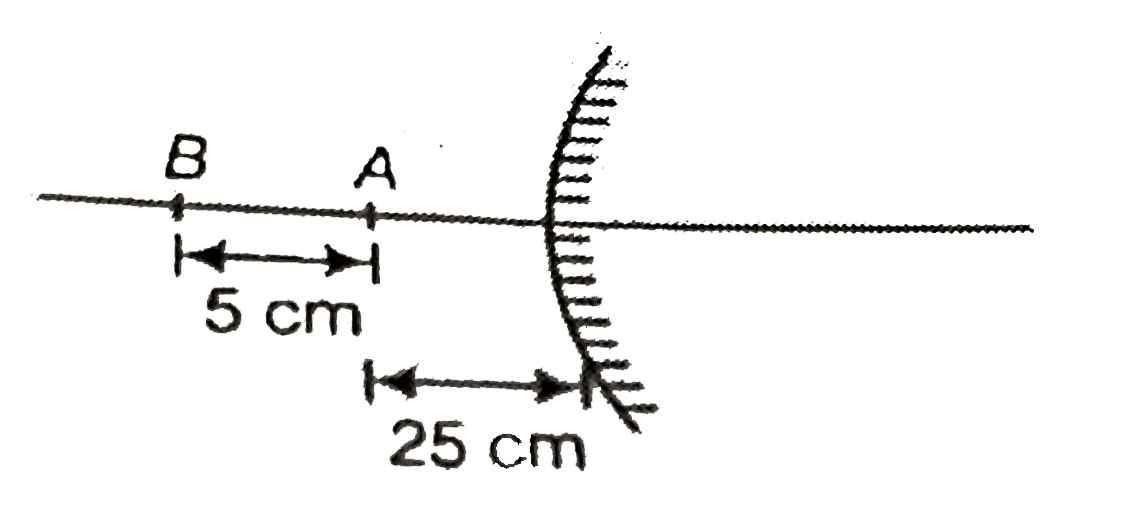 02:14View Solution
02:14View SolutionIf `u` represents object distance from pole of spherical mirror and `V` represents image distance from pole of mirror and `f` is the focal length of the mirror, then a straight line `u=v` will cut `u` versus `v` graph at
02:10View SolutionWhen an object is placed at a distance of 25 cm from a mirror, the magnification is `m_(1)`. The object is moved 15cm farther away with respect to the earlier position, and the magnification becomes `m_(2)`. If `m_(1)//m_(2)=4` , then calculate the focal length of the mirror.
05:19View SolutionThe focal length of plano-convex lens, the convex surface of which is silvered is `0.3m`, if `mu` of the lens is `7//4`, the radius of curvature of the convex surface is
05:20View SolutionA convergent doublet of separated lens correct for spherical aberration, are separated by `2m` and has an equivalent focal lenth of `10cm`. Calculate the focal length of its component lenses.
03:19View SolutionA ray of light travelling in glass `(mu_g=3//2)` is incident on a horizontal glass-air surface at the critical angle `theta_C.` If a thin layer of water `(mu_w=4//3)` is now poured on the glass-air surface. At what angle will the ray of light emerges into water at glass-water surface?
02:39View SolutionA small coin is resting on the bottom of a beaker filled with a liquid. A ray of light from the coin travels up to the surface of the liquid and moves along its surface (see figure ).
How fast is the light travelling in the liquid ?
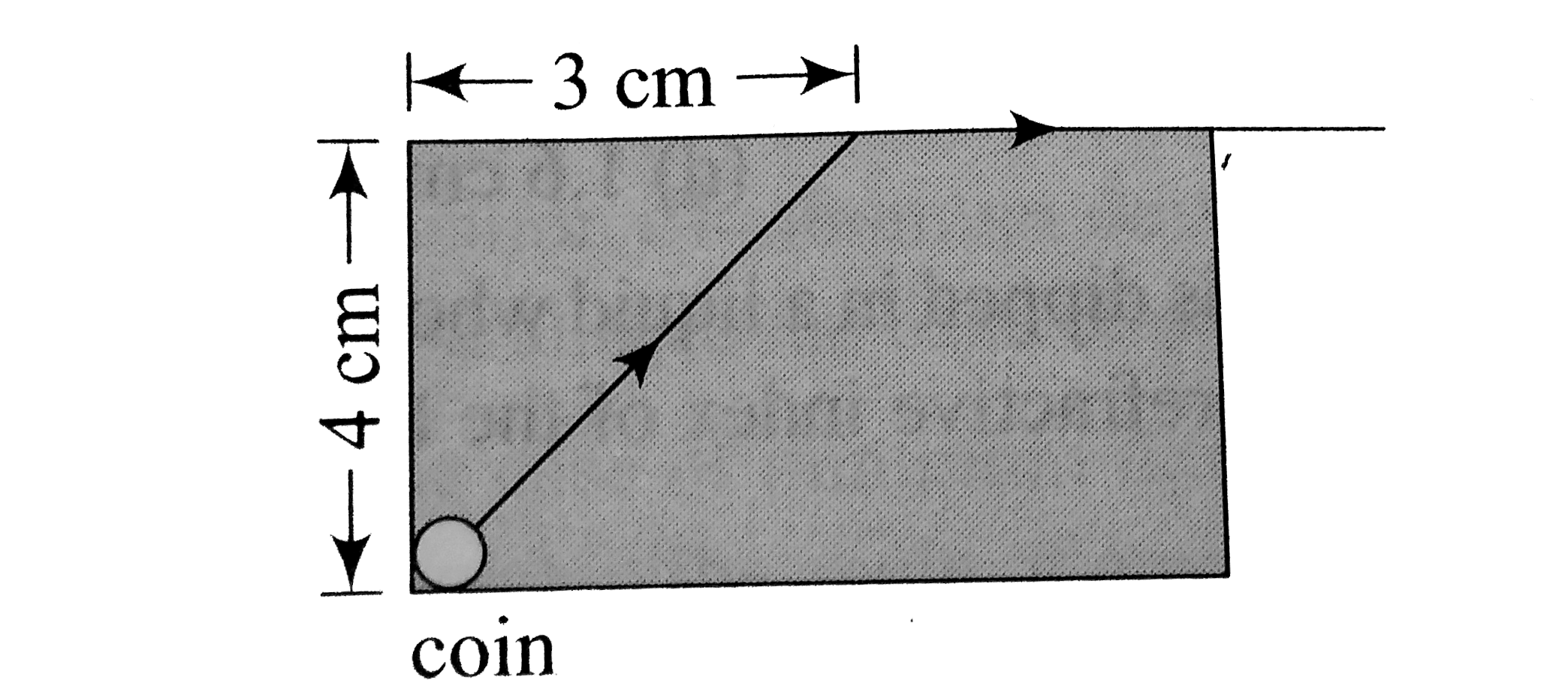 04:08View Solution
04:08View SolutionConsidering normal incident of ray, find equivalent refractive index of combination of two slabs shown in figure.
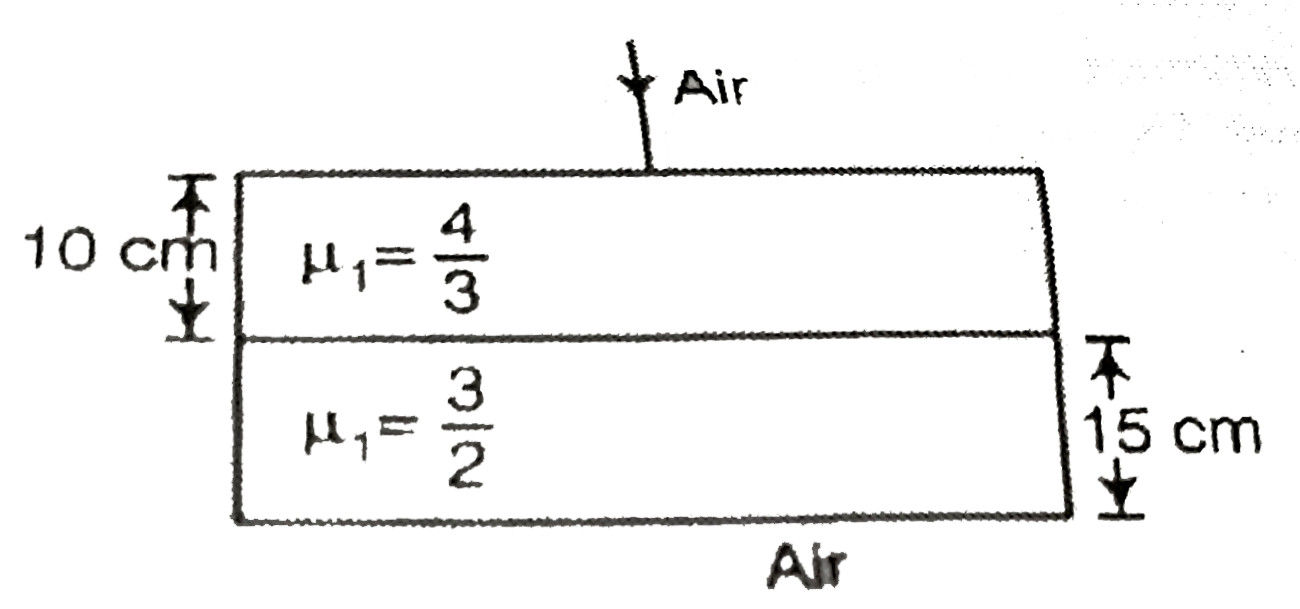 01:54View Solution
01:54View SolutionA tank contains two different liquids which do not mix with each other. The lower and upper liquid are at depth `h_(1)` and `h_(2)` respectively and of refractive indices `mu_(1)` and `mu_(2)`. An object `O` is located at the bottom, when see vertically from above. Locate the position of image of the object `O` as seen from above.
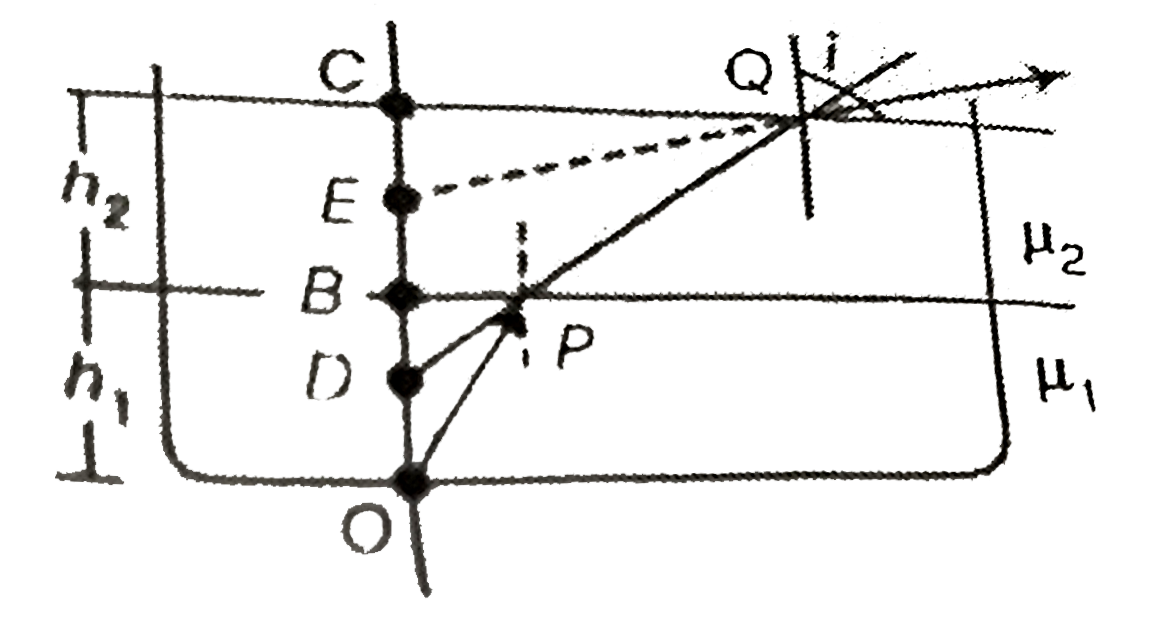 03:40View Solution
03:40View SolutionA fish rising up vertically toward the surface of water with speed `3ms^(-1)` observes a bird diving down vertically towards it with speed `9ms^(-1)` . The actual velocity of bird is
 02:28View Solution
02:28View SolutionA telescope consists of two lenses of focal lengths `10cm` and `1cm`. Calculate the length of the telescope, when an object is kept at a distance of `60cm` from the objective, and the final image is formed at least distance of distinct vision.
05:19View SolutionA glass prism of refractive index 1.5 is immersed in water (refractive index 4/3). A light beam incident normally on the face AB is totally reflected to reach on the face BC if.
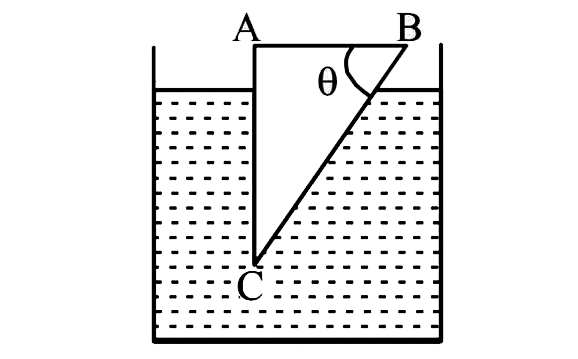 02:47View Solution
02:47View SolutionIf the resolution limit of the eye is 1 minute and at a distance `x` km from the eye, two persons stands with a lateral separation of `3m`, then calculate `x` for which the twok persons can be just resolved by the nacket eye.
02:32View SolutionA ray incident at a point at an angle of incidence of `60^(@)` enters a glass sphere with refractive index `sqrt(3)` and it is reflected and refracted at the farther surface of the sphere. The angle between the reflected and refracted rays at this surface is:
03:18View SolutionAn object appraches a convergent lens from the left of the lens with a uniform speed `5m//s` and stops at the focus. The image
03:42View SolutionA concave lens and a convex lens have same focal length of `20 cm` and both put in contact this combination is used to view an object `5 cm` long kept at `20 cm` from the lens combination. As compared to object the image will be
03:28View SolutionA source of light lies on the angle bisector of two plane mirrors inclined at angle `theta`. The value of `theta`, so that the light reflected from one mirror does not reach the other mirror will be.
02:30View SolutionOn the axis of a spherical mirror of focal length `f` a short linear object of length `L` lies on the axis at a distance `mu` from the mirror. Its image has an axial length `L'` equal to
07:29View SolutionThe speed at which the image of the luminous point object is moving, if the luminous point object is moving at speed ` v_(0)` towards a spherical mirror, along its axis is
(Given, `R=` radius of curvature `u=` object distance)03:37View SolutionA thin convergent glass lens `(mu_g=1.5)` has a power of `+5.0D.` When this lens is immersed in a liquid of refractive index `mu_1,` it acts as a divergent lens of focal length `100 cm.` The value of `mu_1` is
03:26View SolutionThe reflective surface is given by `y=2 sinx`. The reflective surface is facing positive axis. What is the least value of coordinate of the point where a ray parallel to positive `x`-axis becomes parallel to positive `y` -axis after reflection?
03:55View SolutionWith a concave mirror, an object is placed at a distance `x_(1)` from the princiipal focus, on the principal axis. The image is formed at a distance `x_(2)` from the principal focus. The focal length of the mirror is
02:18View SolutionAn electromagnetic radiation of frequency v, wavelength `lamda`, travelling with velocity c in air, enters a glass slab of refractive index `mu`. The frequency, wavelength and velocity of light in the glass slab will be respectively.
03:09View SolutionWhen a glass slab is placed on a cross made on a sheet, the cross appears to be raised by `1cm`. The thickness of the glass is `3cm`. The critical angle for glass is
02:39View SolutionA layered lens is made of materials indicated by shades in the figure. The number of images formed is
 02:37View Solution
02:37View SolutionResolving power of a telescope will be more, fi the diameter (a) of the objective is
01:02View Solution
A point object is placed at the focus of the bio-conved lens. What should be the value of `X`, so the final image forms at infinity?02:55View SolutionA ray of light is incident on the interface between water and glass at an angle `i` and refracted parallel to the water surface, then value of `mu_(g)` will be
 02:16View Solution
02:16View SolutionIn the Young's double slit experiment , a mica slip of thickness t and refractive index `mu` is introduced in the ray from first source `S_(1)` . By how much distance fringes pattern will be displaced ? (d = distance between the slits and D is the distance between slits and screen)
05:28View SolutionA film projector magnifies a `100cm^(2)` film strip on a screen. If the linear magnification is 4, the area of the magnified film on the screen is
02:05View SolutionA convex lens makes a real image 4 cm long on a screen. When the lens is shifted to a new position without disturbing the object, we again get a real image on the screen which is 16 cm tall. The length of the object must be
07:06View SolutionThe maximum value of index of refraction of a material of a prism which allows the passage of light through it when the refracting angle of prism is A is
06:19View SolutionThe focal lengths of objective and the eyepiece of a compound microscope are `f_(o)` and `f_(e)` respectively. Then,
02:46View SolutionWhich of the following is a wrong statement?
02:36View Solution
All Questions questions and complete solutions for chapter RAY OPTICS of BITSAT GUIDE of Class 12
